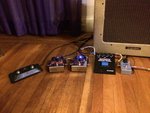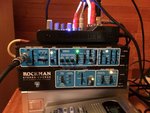If you had the Rockman Ace, they are bottom of the line. The 9 volt power limits their headroom and the noise floor becomes noticeably more obvious because of it. The Ace is just the amp simulation, with no effects. Dunlop compounds this by shipping the Ace with fairly awful headphones. Using the Ace is noticeably better with good headphones. I own two Ace's and use them as practice and demo amps. They are perfectly suitable for that purpose.
The other headphone amplifiers have a much better reputation. There was the original Rockman, the Ultralight, X100 and Soloist. The original Rockman was released in 1982. It includes an amplifier simulator, stereo chorus and reverb. It has two clean sounds, along with "Edge" and a distortion modes. The chorus and reverb are tied together, both being on when the switch was set to normal. You can disable the chorus or reverb, but not both at the same time.
Production of the Rockman Ultralight, began in 1983. It was a more economical alternative to the Rockman. It is very similar to the Rockman but lacks the reverb. Uniquely, the chorus can be disabled, providing a dry output from the amplifier simulator. Both the original Rockman and Ultralight models were continued until 1984.
The X100 is very similar to the original Rockman in its feature set, but uses a different clipping stage in the amplifier simulation.
The Rockman Soloist was positioned as a lower cost Rockman product. It does not have the "Clean 2" voice. It also has different choices for effects, including a setting for chorus and a "stereo" setting that has a fixed 25 millisecond delay. It can be set to "Mono" output, removing all the effects.


